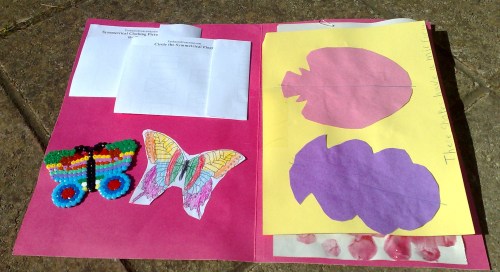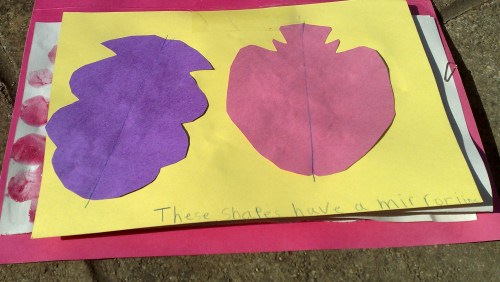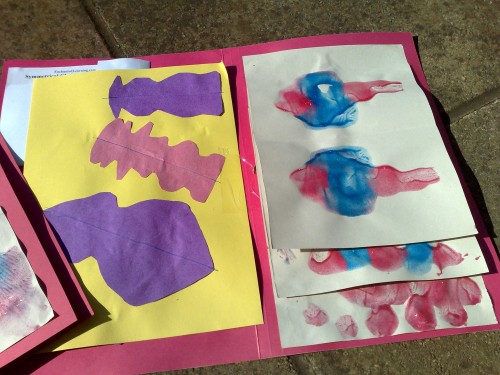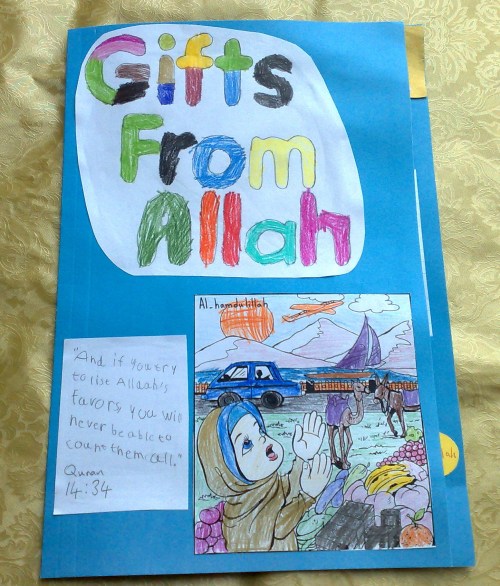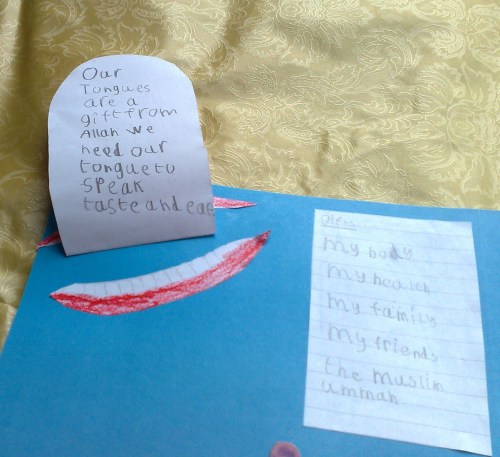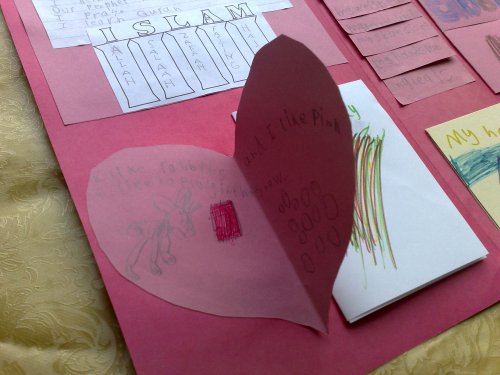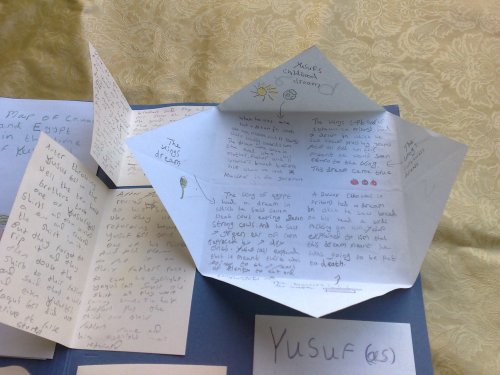This lapbook was devised from a series of lesson plans written several years ago by a friend. I have included the plans more or less as they were written, as they form a good discussion base. They are written with a group of children in mind, but are easily adapted for use with one child. When role plays are called for, the parent can take a role, and even soft toys can be used to play the parts of other people!
Following the plan for our project, we began by thinking about the real necessities for our lives, how money is required, and how zakat is used to help the poorest in society meet their basic needs.
ZAKAT
Part 1
Aim: To establish that there are basic essentials in life that we all need.
Lesson 1
Aim: To establish that we need food to prevent hunger.
Begin by asking the children what they had for breakfast. Did anyone have nothing for breakfast? How would you feel now if you had had nothing for breakfast?
Look in your lunchboxes. Talk about what you have. Use one child’s lunchbox as an example. Take out one small item, such as a grape. Close the box and ask the children to imagine that today that is all they would get for lunch. Talk about this. How do they feel when they are hungry?
- Draw stick men pictures and label them to show how we feel when we are hungry. (tummy ache, tired, cross, sick, headache, dizzy)
- Ask them if it is nice or good to feel hungry. Ask them what they need to do when they feel hungry. Get out a small snack. What do we say before we eat? We remember Allah because Allah provides us with food. Give each child a snack and say bismillah together. Say alhamdulillah together after eating the snack.
3. Show the children a selection of pictures of foods. Ask each child to select what he would like to have and why. Then show the children half a crust of plain bread and say that that you have not got any of the foods in the picture, you only have the crust. Discuss their response.
4. Ask them if we need food. Why? How would it be if you had no food?
Explain that some people have very little food.
Ask where our food comes from. It is given to us by Allah.
5. Display various pictures of foods. The children make pictures of foods they like by drawing or collage. Write “Alhamdulillah”.

Lesson 2
Aim : Establish that we need homes to protect us.
Begin by reminding the children about the last lesson. Elicit that we need food. Say that today we will talk about something else that we need. Ask the children where they live and ask them to describe their home. What do they like about their home?
When it is rainy/ cold/ windy/ snowy outside how does it feel inside your home? If you had no home and had to sleep outside what would happen to you?
Show the children pictures of homes around the world. Discuss how those homes suit their climate. Ask who provides us with our homes. Elicit that Allah provides us with everything, including our homes.
- The children draw pictures of their homes with a weather background showing a wet or cold day or night. Write “Al hamdulillah”. When each child has finished he can display his work and explain that Allah has provided him with his home to protect him from the weather, (and any other reasons that the child may have thought of). Weather reasons are focused on here in order not to cause the children to worry about dangers outside the home. These things can be discussed if the children mention them first.
- Explain that some people do not have homes. Why? People usually have to pay rent or pay to buy a home and some people do not have the money for that. This may be a difficult concept to put across as the children may find it hard to imagine that a home has to be paid for as they will not have witnessed a cash transaction being made for it. They may have lived in their home for as long as they can remember and just feel it to be naturally theirs. It may be especially shocking for them to realize that their home actually belongs to someone else; the landlord.
- Using Lego or other building materials ask the children to build little houses. Give the houses to one child and explain that he owns all the houses but he would like other people to pay him and live there as he does not need them all himself.
- Say that each house costs 100 per month. Give each child a piece of paper with a number on it to show how much they can pay each month. Some have enough, others do not. The children role play asking to live in a house and being accepted or refused. Those who are accepted are given a model house.
- Discuss the outcome of the role play. Encourage the children to think about the problem of not being able to afford a home. Again thank Allah for the homes we have.

Lesson 3
Aim: Establish that we need clothes to protect and cover us.
Begin by reminding the children about the last lessons. Elicit that we need food and housing. Explain that today we will talk about something else that we need.
Remark on the weather today. How does it feel? Discuss the clothes that the children are wearing or would need to wear if they were going outside. Relate the clothing worn to the weather.
Show the children a picture of hot places and cold places. Using a few items of clothing ask them which clothing they would need for each place. You could use a winter coat, a jubba, a sun hat etc. Discuss the possible outcomes of wearing the wrong clothes.
- Draw pictures of clothing worn on hot or cold days and label.
- Ask the children to imagine only having canvas shoes to wear on a wet day, or only having short sleeved clothes in winter. Talk about how this would feel.
Establish that we need clothes to protect us.
Then move on to the concept of clothes covering us.

The last part of Ummahmoud’s lesson plan involved a role play. This can’t appear in a lapbook of course, but it is still part of the project.
Begin by discussing briefly what zakat is, who gives it and that the poor have a right to part of the wealth of the rich.
Then discuss the essentials required for living (food, housing, clothes). The children need to be reminded of these.
- Each child is given some money and is asked to allocate some of it for spending on food, some for housing and some for clothes. The rest they put aside as saving. From the saving they then role play giving some money to someone assigned as the poor person.
- Divide the class into two groups. Half are to role play rich people, and are given some money. The others are to role play poor people. One poor person is without food, another without a home and another without adequate clothing. The children role play, the rich person approaching the poor and discussing his needs with him and then giving him some money.
At this stage the children are being introduced to the act of giving and do not need to know that zakat should be organized by the state. They are also not old enough to understand the calculation for zakat.
For other parts of the lapbook I cut out bits of other resources I had. Unfortunately I do not know where some of these originally came from. If you recognise anything here, let me know in the comments, so that I can acknowledge the producers.
The resources consist of simple drawings and text, which can easily be hand replicated.
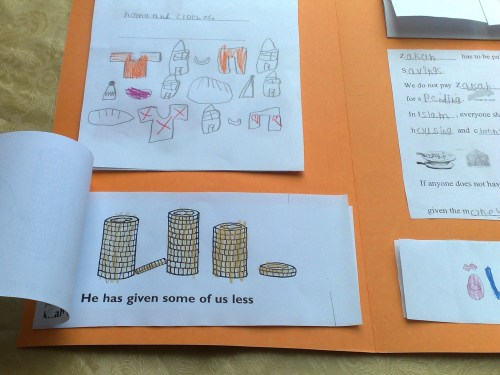
The booklet at the bottom of the picture has three pages, with text reading “Allah has given some of us a lot of wealth”, “He has given some of us less” and “Some of us have very little”.
While making this booklet you can discuss with your child how wealth is a responsibility and a test, and that Allah wants us to share whatever we have with those less fortunate.

The booklet above illustrates zakat as the 3rd pillar of Islam. The other flaps fold down on top of each other.

Above is a simple cloze exercise, explaining zakat, and then a further explanation written under a label of Zakat written in Arabic.

Above, overview of the lapbook.
Below, the front cover.
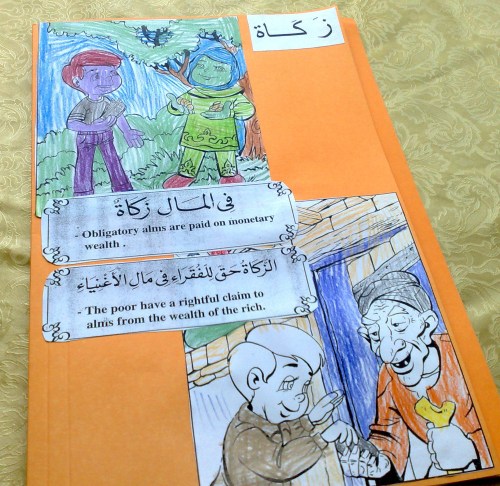
Read Full Post »
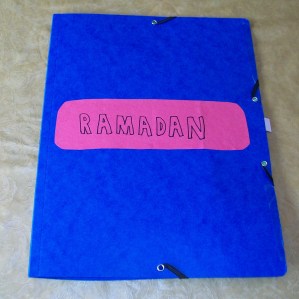
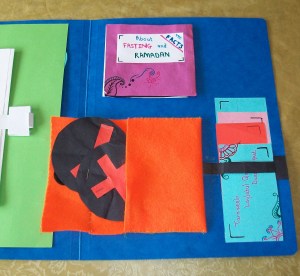



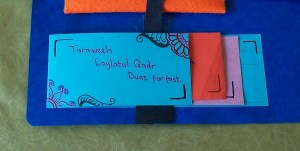



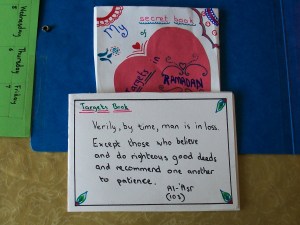
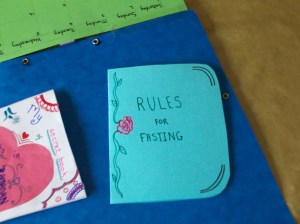


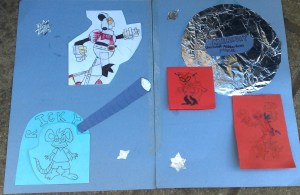








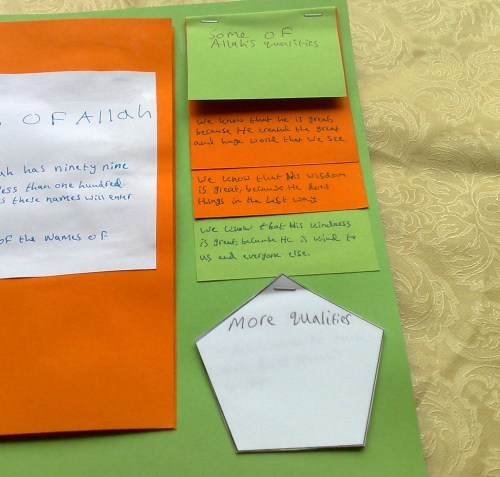

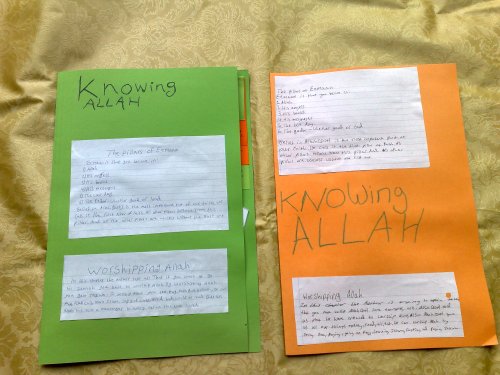
 I did a practical project on reflection with my daughters, and gathered together whatever could be done on paper into a lapbook. The following pictures are from my 6 year old’s lapbook.
I did a practical project on reflection with my daughters, and gathered together whatever could be done on paper into a lapbook. The following pictures are from my 6 year old’s lapbook.